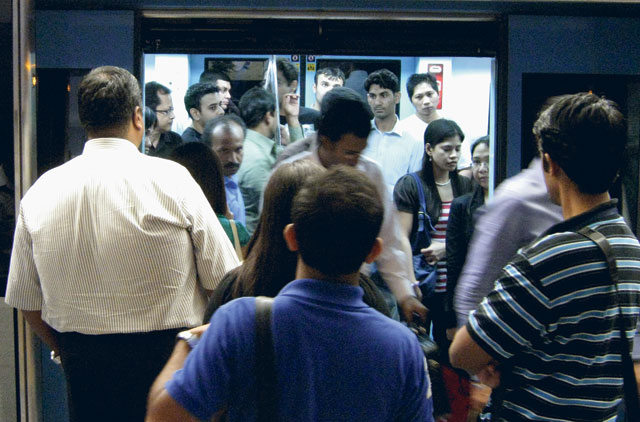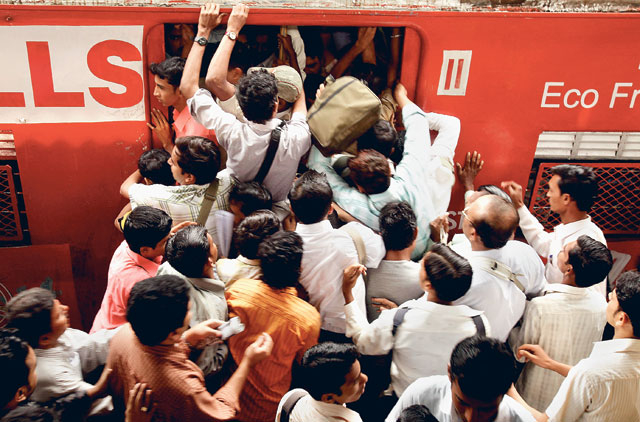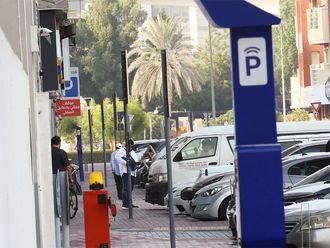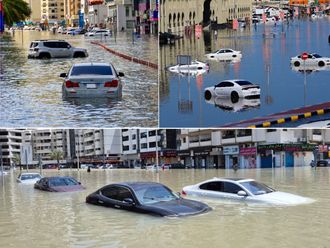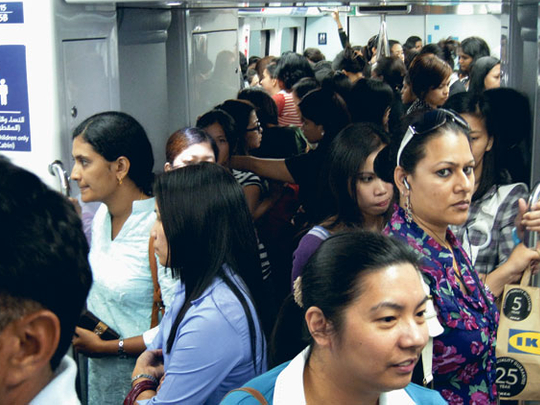
Dubai : It's 7.30am at Rashidiya Station and a few stray passengers board the Metro, find a comfy seat, plug in their earphones and hope to doze for the next hour or so, oblivious to the chaos that is about to come.
Five stations into the journey, at the Deira City Centre, the passengers board in the hundreds. By the time the train reaches Khalid Bin Al Waleed station, people are standing shoulder to shoulder, or "mouth to mouth", as one man puts it.
Johann Smith, a businessman who travels to DIFC (Dubai International Financial Centre) daily, admits that while it isn't a dog-eat-dog situation, he sees it heading that way soon. "At the moment, no one pushes and shoves. They stand alone in their misery, with beady eyes looking out for the first available seat."
Smith points out to the predominantly Indian and Filipino commuters who all carry the same blank-eyed gaze. Laxmi Chauhan, an Indian woman no taller than five feet, complains loudly.
"It's the same story every day. Because of my height and the lack of space in the compartments, I always have someone's armpit in my face."
On a train with 142 seats and a maximum capacity of 897 there are well over 1,000 passengers.
Welcome to the world of rush hour travel on Dubai Metro.
Since the launch on September 9 last year, 30 million passengers have commuted on the Metro. But is the Metro ready to handle the extra load since the opening of five new stations in October?
The feedback from rush hour Metro users is ambiguous. With an expected 170,000 expected to ride per day by the end of 2010, the general consensus is that RTA needs to make some changes if they want to accommodate so many on a daily basis. Despite RTA's assurance of having increased the frequency of trains to handle the extra load, passengers who brave Dubai's rush hour beg to differ.
Women and children
"I've noticed women and children have to stand through their journey, while there are men all around them sitting comfortably," says Jane D'Costa, an Indian secretary. "On the odd lucky day, there'll be a gentleman who offers me his seat. Normally, most people stand cramped, waiting for passengers to get off so they can get a precious seat, if only for a few minutes."
Angolan mum Maria Rui, who boards daily from Union, the largest station capable of handling up to 22,000 passengers per hour, disagrees. "Although most people don't offer me a seat, I've noticed that when there is a spare seat available, the majority of men allow the women on board first choice to take the seat. Filipino men are the most chivalrous."
RTA says 22 trains run during peak hours and 16 during regular hours. The frequency varies on weekdays and peak hours and ranges from eight to six minutes. Service frequency is 10 minutes from 9pm to 11 pm from Saturday to Wednesday, eight minutes on Thursday and Friday, 10 minutes from 11pm to 12 midnight, and eight minutes on Fridays.
Despite these changes, passengers say that the only change they've noticed is the increase in the number of people on each train. Ravi Bhandari, an Indian financial controller boards the Metro at 8.30am from Khalid Bin Al Walid station.
"As new stations keep opening, the number of people on board each train keeps increasing. We've already reached bursting point and RTA needs to increase frequency to accommodate this crowd.
Also, put a restriction on the number of people on a train. It's maddening to travel on one toe while hanging on for dear life to whatever or whoever I can get hold of," he says. Bhandari's frustration has led him to consider investing in a car, just so he can "sit in peace on the way to Jebel Ali every morning."
If Bhandari does that, it would go against the very grain of what RTA is trying desperately to achieve: to get people off the roads and onto the Metros.
On November 1, RTA offered free rides for Nol card holders. Earlier, it plastered 7,000 cars with magnets featuring images of fried eggs. The magnet had a clear message: "it's a cool 20 degrees C on the Metro'.
"That's all well and good," says Indian Mary-Divya Thomas. "But how do they expect to fit so many more people into a space that's already overcrowded?"
Packed to capacity
And yet, despite being packed like sardines in a can, commuters are still making the trip, day after day. "What other choice do I have?" asks Filipina nurse Karen Sabiniano. "I have to make a daily commute from Bur Dubai to Shaikh Zayed Road. Taxis are too expensive. The trains are overcrowded, but I'm not really paying for luxury here."
By 9.30am, the Metro is nearly empty. Come 5pm, however, the commotion begins all over again - except the crowds seem to have multiplied in numbers. Swedish mum Annika Lundgren says she only travels in the women's carriage since the crowds are even more maddening in the other compartments.
"Rock concerts look deserted in comparison to the hordes of passengers on this train." Lundgren, who boarded at Business Bay station, said riding during peak hour was a mistake.
"Since I don't drive, I figured I'd hop on the Metro. Never again. If only someone had warned me that I'd be nearly crushed to death for the duration of the journey, I'd have paid for a taxi ride home. I'd even have walked home, rather than be stuck in this mess." True to her word, she got down at the Financial Centre station.
The voices may differ, but the message is clear: ‘It's overcrowded; RTA needs to make changes or I come home every evening smelling like a thousand different people.' "Convenience of commuters is our top priority," says Ramadan Abdullah, Director of Rail Operations at RTA.
Rush hour commuters can only hope.


